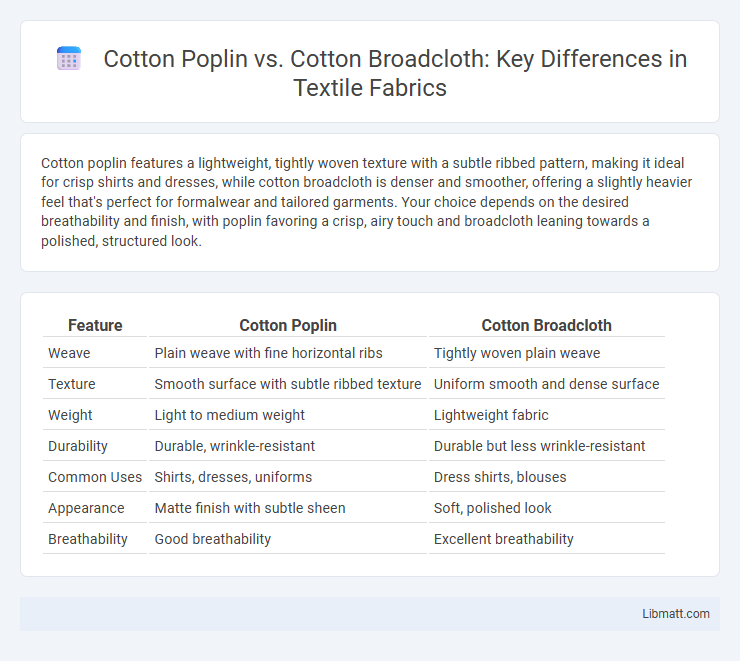Cotton poplin features a lightweight, tightly woven texture with a subtle ribbed pattern, making it ideal for crisp shirts and dresses, while cotton broadcloth is denser and smoother, offering a slightly heavier feel that's perfect for formalwear and tailored garments. Your choice depends on the desired breathability and finish, with poplin favoring a crisp, airy touch and broadcloth leaning towards a polished, structured look.
Table of Comparison
| Feature | Cotton Poplin | Cotton Broadcloth |
|---|---|---|
| Weave | Plain weave with fine horizontal ribs | Tightly woven plain weave |
| Texture | Smooth surface with subtle ribbed texture | Uniform smooth and dense surface |
| Weight | Light to medium weight | Lightweight fabric |
| Durability | Durable, wrinkle-resistant | Durable but less wrinkle-resistant |
| Common Uses | Shirts, dresses, uniforms | Dress shirts, blouses |
| Appearance | Matte finish with subtle sheen | Soft, polished look |
| Breathability | Good breathability | Excellent breathability |
Introduction to Cotton Poplin and Cotton Broadcloth
Cotton poplin is a lightweight, plain-weave fabric known for its smooth texture and durability, commonly used in shirts and dresses. Cotton broadcloth features a tighter weave and slightly heavier weight, offering a crisp finish ideal for formalwear and tailored garments. Both fabrics are made from 100% cotton fibers but differ primarily in weave density and texture, affecting their breathability and drape.
Defining Cotton Poplin: Key Characteristics
Cotton poplin is a tightly woven fabric characterized by its fine, smooth texture and subtle ribbed appearance, created by the crosswise weave of weft and warp threads. It offers durability and a crisp finish, making it ideal for shirts, dresses, and lightweight garments. Poplin's breathability and slight sheen distinguish it from other cotton fabrics like broadcloth, which has a denser weave and softer finish.
What Sets Cotton Broadcloth Apart
Cotton broadcloth is distinguished by its tightly woven, smooth texture and fine finish, which gives it a lustrous appearance and a more refined feel compared to cotton poplin. Its dense weave results in enhanced durability and a slightly heavier weight, making broadcloth ideal for dress shirts and formal wear where a crisp, polished look is essential. Your choice between these fabrics depends on whether you prioritize the subtle sheen and structure of broadcloth or the lighter, more breathable quality of poplin.
Weave Structure: Poplin vs Broadcloth
Cotton poplin features a plain weave with a slightly heavier weft than warp, creating a fine horizontal ribbing that adds subtle texture and durability. Cotton broadcloth uses a closely woven plain weave with equal warp and weft threads, resulting in a smooth, dense, and lustrous surface ideal for crisp shirts. Understanding the weave structure helps you choose between poplin's textured feel and broadcloth's polished touch for your garment needs.
Texture and Feel: Comparing the Fabrics
Cotton poplin features a smooth, crisp texture with a fine, tight weave that gives it a slightly lustrous finish, ideal for formal shirts and lightweight garments. Cotton broadcloth, while also tightly woven, has a softer, denser feel with a matte finish, offering a more substantial drape and a comfortable, breathable experience. Both fabrics provide durability and wrinkle resistance, but poplin emphasizes a sleek, polished look, whereas broadcloth prioritizes softness and casual wearability.
Durability and Strength Differences
Cotton poplin features a tighter weave with a plain weave structure, providing a smooth surface and moderate durability ideal for lightweight apparel. Cotton broadcloth has a denser weave and a finer finish, making it stronger and more durable, suitable for shirts and garments that require long-lasting wear. The difference in tensile strength stems from broadcloth's higher thread count and tighter threads, enhancing its resistance to wear and tear compared to poplin.
Popular Uses for Cotton Poplin
Cotton poplin is widely used in the fashion industry for making dress shirts, blouses, and lightweight summer dresses due to its smooth texture and breathability. Its fine, tightly woven yarns also make it ideal for crafting children's clothing and high-quality casual wear. Designers favor cotton poplin for its durability and subtle sheen, which provides a polished, professional appearance in everyday apparel.
Common Applications of Cotton Broadcloth
Cotton broadcloth is widely used in dress shirts, blouses, and lightweight jackets due to its smooth texture and tight weave, which offer durability and a crisp finish. Its fine, closely woven fibers make it ideal for tailored garments requiring a clean, polished appearance. The fabric's breathable nature also suits casual wear and children's clothing, where comfort and longevity are essential.
Care and Maintenance: Which Is Easier?
Cotton poplin is generally easier to care for due to its tighter weave and smoother surface, making it less prone to wrinkles and requiring minimal ironing. Cotton broadcloth, while also durable, tends to wrinkle more easily and often needs frequent pressing to maintain a crisp appearance. Both fabrics are machine washable, but poplin's wrinkle resistance and quicker drying time give it an edge in low-maintenance care.
Choosing Between Cotton Poplin and Broadcloth
Cotton poplin features a fine, tightly woven plain weave with a crisp texture and slight sheen, making it ideal for structured garments like shirts and dresses. Cotton broadcloth has a denser weave with a smoother finish and a soft hand, preferred for formal shirts due to its durability and polished look. When choosing between cotton poplin and broadcloth, consider the desired fabric weight, texture, and breathability to match your garment's purpose and comfort needs.
Cotton poplin vs Cotton broadcloth Infographic

 libmatt.com
libmatt.com